Class 11-science H C VERMA Solutions Physics Chapter 7 - Circular Motion
Circular Motion Exercise 114
Solution 1
Speed of the moon=distance/time
![]()
![]()
=1025.4m/s
Acceleration of moon=
![]()
Ar = 2.73 × 10-3m/s2
Solution 2
Speed of particle at equator=distance/time
![]()
![]()
=465.1m/s
Acceleration of particle=
![]()
![]()
Ar = 0.038m/s2
Solution 3
(a)
Velocity of particle at t=1 sec
V=2t
V=2(1)
V=2cm/s
Radial acceleration
![]()
Ar=4cm/s2
(b)
Tangential acceleration
At=
![]()
At=2cm/s2
(c)
An= ![]()
An= ![]()
An =![]() cm/s
cm/s
Solution 4
Horizontal force required=Centrifugal force
![]()
![]()
F=500N
Solution 5
Let banking angle be θ
tan
θ=![]()
tan
θ=![]() =
= ![]()
![]()
Solution 6
Let banking angle be θ
tan
θ =![]()
tan
θ
=![]()
![]()
Solution 7
Centrifugal force=Frictional force
![]() = µN
= µN
![]() =µmg
=µmg
µ= ![]() =
= ![]()
µ=0.25
Solution 8
tan θ=![]()
tan30° =![]()
v ≅ 17m/s
Solution 9
Coulomb force=Centrifugal force
![]() =
=![]()
![]() =(9.1 ×
10-31
)v2
=(9.1 ×
10-31
)v2
V=2.2 × 106m/s
Solution 10
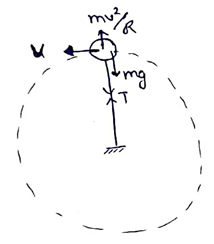
At highest point
T
+ mg = ![]()
For minimum speed, T=0
![]()
![]()
Solution 11
Radius
of the circle = ![]() = 60cm
= 60cm
Angular speed=1500rpm
ω
=1500 × ![]()
ω =157 rad/sec
Force=mRω2
![]() (0.6 )(157)2
(0.6 )(157)2
F=14.8N
This force is exerted by friction. On particle it acts towards the centre of the circle and on fan blade outside the circle due to action-reaction pair.
So, force along the surface=14.8N
Solution 12
ω = 33
![]() rpm =
rpm = ![]() rpm
rpm
![]()
![]()
For mosquito to remain at rest on L.P record.
Frictional force ≥ Centrifugal force
µN ≥ mRω2
µmg ≥ mRω2
![]()
![]()
Solution 13
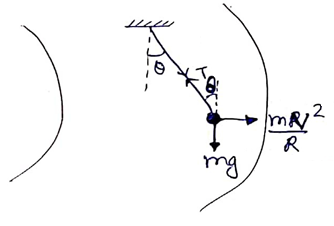
Tsin θ=![]() ------------------ (1)
------------------ (1)
Tcosθ =mg -------------------(2)
Divide,
tan
θ
=![]()
tan
θ
=![]()
θ = 45°
Circular Motion Exercise 115
Solution 14
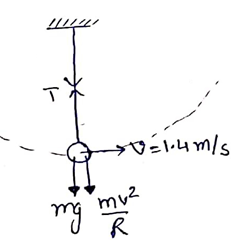
At lowest point
![]()
=
(0.1)(10) + ![]()
T = 1.2N
Solution 15
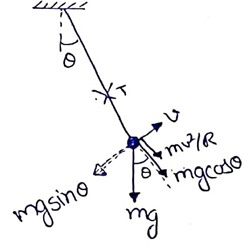
At angle θ
![]()
T
= mg(1-![]() )+
)+ ![]()
T
= (0.1)(10)(1- ![]() )+
)+![]()
T ≃ 1.16
Solution 16
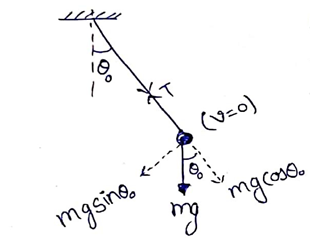
At extreme position,
T= mgcos θ0
(No centrifugal force as v=0 at extreme position.)
Solution 18
For banking angle,
tan
θ=![]()
=![]()
tan θ=0.5

![]()
=15m/s
![]()
=54kmph
Vmin=![]()
=![]()
=4m/s
Vmin=14.7kmph
Solution 19
(a)
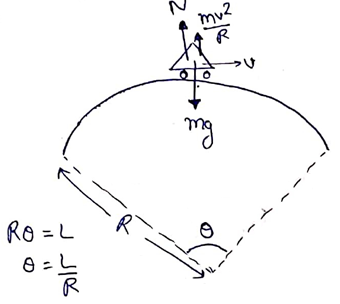
At highest point,
![]()
For maximum speed, N=0
![]()
Vma×=![]()
(b)
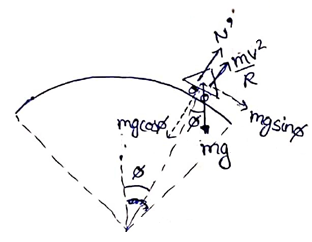
V=![]() =
=![]()
Let at angle 𝚽 it loses its contact with road
N'=0
N'+![]() =mgcos𝚽
=mgcos𝚽
0+![]() = mgcos𝚽
= mgcos𝚽
Cos𝚽=![]()
𝚽=60° or ![]() rad.
rad.
So it loses contact after a distance πR/3 along the bridge from the highest point.
(c)
Normal contact at any angle 𝚽
N'=mgcos 𝚽- ![]() ---->(1)
---->(1)
So, as motorcycle moves along the curve 𝚽 increases, so cos𝚽 decreases and hence N' decreases.
Normal contact will be minimum at the extreme point.
At extreme point
𝚽= ![]() = and N'=0
= and N'=0
From equation (1),
0=mgcos ![]()

Solution 20
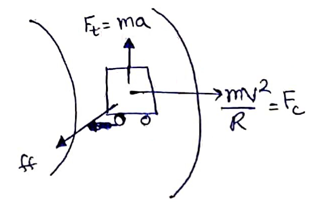
From free body diagram
ff=![]()
µN=![]()
(µmg)
=![]()
Squaring and solving,
v=[(µ2g2-a2)R2]1/4
Solution 21

(a)
For block not to slip
ff ≥ mLω2
µN ≥ mLω2
µmg ≥ mLω2
ω2 ![]()
ωma×=![]()
(b)
Now, ruler makes uniformly accelerated circular motion at angular acceleration of α,so tangential acceleration
At=Lα
Ft = mat
Ft = mLα
Radial force Fc = mLω'2
Where ω' is maximum angular speed at which it slips
µN=![]()
µmg=![]()
squaring and solving,
ω'=[![]() - α2]1/4
- α2]1/4
Solution 22
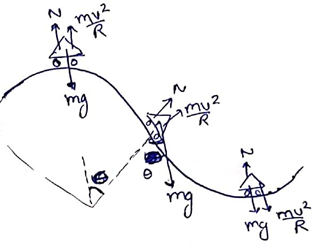
(a)
Velocity
of cyclist![]() =5m/s
=5m/s
At point B
NB
+ ![]() = mg
= mg
NB
= (100)(10)- ![]()
NB = 975N
At point D
ND
= mg + ![]()
ND
= (100)(10) +![]()
ND = 1025N
(b)
No force acts along surface at point B and D
So,ffB=ffD=0
At point C,
∵acceleration=0
So,ffc = mgsinθ
ffc = (100)(10)sin450
ffc = 707N
(C)
Before C,
Nc+ ![]() =mgcos45°
=mgcos45°
Nc=(100)(10)
![]()
NC = 682N
After C,
N'C= ![]() + mgcos45°
+ mgcos45°
N'C
= ![]()
N'C = 732N
(d) ff=µN
For minimum friction force normal contact should be minimum.
Normal contact is minimum at point just before C.
ff=mgsinѲ = µN
(100)(10)sin45°= µ(682)
µ = 1.037
Solution 23

ω =20
rpm=20× ![]()
ω =![]() (rad/sec)
(rad/sec)
R=1.5m
Frictional force=mR ω2
=(15)(1.5)![]()
![]() =10 π2
=10 π2
Solution 24
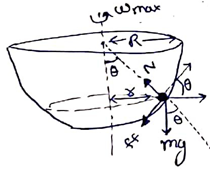
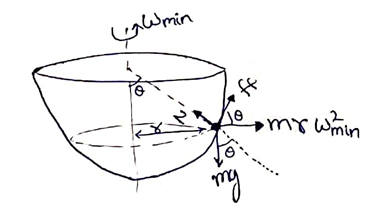
Particle will have tendency to move up. So, frictional force is in downward direction.
r=Rsinθ----->(ί)
N=
mgcosθ+![]() sinθ------->(ii)
sinθ------->(ii)
ff + mgsinθ=
![]() cosθ------->(iii)
cosθ------->(iii)
ff= µN-------->(iv)
on solving,
ωma×=![]()
For ωmin, particle will have tendency to move down. So, frictional force acting upward direction.
r=Rsinθ----->(1)
N=
mgcosθ +
![]() sinθ------->(ii)
sinθ------->(ii)
Mgsinθ =
ff+ ![]() cosθ------->(iii)
cosθ------->(iii)
ff= µN-------->(iv)
on solving,
ωmin=![]()
Solution 25
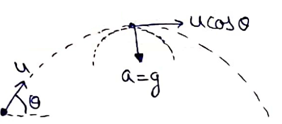
At highest point
Aradial=![]()
![]()
![]()
Solution 26
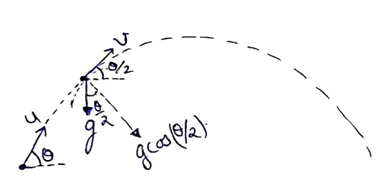
Since acceleration in horizontal direction is zero
ucosθ
=
vcos ![]()
![]()
aradial=![]()

![]()
Solution 27
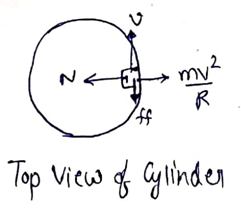
(a)
![]()
(b)
ff=µN= ![]()
(c)
Let acceleration along velocity be at for the block
0-ff=m- at
![]() =mat
=mat
at=-![]()
(d)
V![]() =
=![]()
![]() =
=![]()
lnv|![]() =
=![]() (x)
(x)![]()
V=v0e-2πµ
Circular Motion Exercise 116
Solution 28
Component of force mRω2 along the line AB will be responsible for motion of particle
Force= mRω2cosθ
ma= mRω2cosθ
a=Rω2cosθ
u=0
s=L
using
s=ut+![]() at2
at2
l=![]() (Rω2cosθ) t2
(Rω2cosθ) t2
![]()
Solution 29
(a)

![]()
![]()
N=0.2
(b)
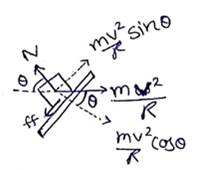
At the time of just sliding
![]()
![]()
![]()
µ=tanθ
θ=tan-1(0.58)
θ=300
Solution 30
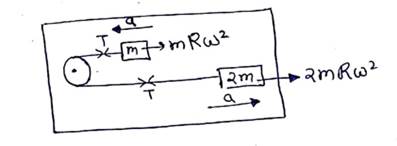
2mRω2-T=2ma
T- mRω2=ma
Adding both,
mRω2=3ma
![]()
T-
mRω2= ![]()
T=![]() mRω2
mRω2
Circular Motion Exercise 155
Solution 17

(a)
At equator, normal contact force
N+mRω2=mg
Reading N=mg-mRω2
So,
fraction less than true weight=![]()
=![]()
=![]()
![]()
=3.5×10-3
(b)
Balance
reading=![]() (True weight)
(True weight)
mg-mRω2=![]() ( (mg)
( (mg)
mRω2=![]()
ω=![]() =
= ![]()
T'=2×3.14×![]() (in sec)
(in sec)
T'=![]() (in hrs.)
(in hrs.)
T'=2hrs

